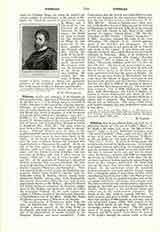

Tiberias, titular see, suffragan of Scythopolis, in Palaestina Secunda. The town of Tiberias was founded on the lake in A.D. 17 by Herod Antipas, tetrarch of Galilee, who gave it the name of the reigning emperor, Tiberius. As tombs were discovered there at the time of its foundation the Jews refused to dwell there, and Herod was forced to populate it with foreigners and people of low extraction (Josephus, “Ant. jud.”, XVIII, ii, 3). What it was previously called is not known; St. Jerome makes it the site now of Reccath, now of Emath, now of Cenereth or Kinnereth, towns of Nephthali (Jos., XIX, 35). The town seems to have been a little more than three miles in circumference. Although Tiberias gave its name to the neighboring lake and is mentioned several times in the Gospels, it seems never to have been dwelt in by Christ. At the death of Herod Antipas in 41, Nero gave the town to Herod Agrippa the Younger who made Sephoris or Diocaesarea his capital. At the revolt of the Jews against the Romans the people of Tiberias sided now with one party, now with the other, and the Jewish historian Josephus, who was Governor of Galilee, only took it after several attempts (“Bell. jud.”, II, xxi, 6; “Vita Josephi”, 18 and 54). At the approach of Vespasian it submitted without resistance and was not disturbed; the Jews secured the privilege of dwelling there alone, to the exclusion of pagans, Christians, and Samaritans. Towards the end of the second century the Sanhedrin was removed thither from Sephoris together with the Talmudic school of Jamnia, whence issued many celebrated Rabbis, among them Juda Hakkodesh, who shortly afterwards codified the vast body of laws and customs known as the Mishna. Between 230 and 270 Rabbi Jochanan composed the Gemara, supplement of the Mishna, and these two codes are called the Jerusalem Talmud. In the sixth century the school of Tiberias produced the celebrated Masorah, or fixed Hebrew text of the Bible. Rabbi Bar Anina of Tiberias gave lessons in Hebrew to St. Jerome.
The introduction of Christianity dates from the time of Constantine the Great. It was Count Joseph, a Jewish convert of this town living at Scythopolis, who built its first church, perhaps on the site of the Hadrianeum (a temple founded by the Emperor Hadrian and never completed). Under Constantine also the Jewish patriarch Hillel was converted and baptized by the missionary bishop who bore the title of Tiberias but resided elsewhere (P.G., XLI, 409-29). Among its bishops were: John, present at the Robber Synod of Ephesus and the Council of Chalcedon in 449 and 451; John II, at the councils of 518 and 536; George, in 553; Basil, in the eighth century (Le Quien, “Oriens christ.”, III, 705-10); Theodore, in 808 (Tobler, “Itinerar. hierosolym.”, I, 304). Justinian restored the walls of the town (Procopius, “De aedificiis”, V, 9). Ancient pilgrims speak of its churches and synagogues. At the Frankish occupation it was given in fief to Tancred who made it his capital. A new town was built, churches restored, and a Latin diocese was instituted, suffragan to Nazareth. Many of its residential or titular bishops are known (Du Cange, “Families d’outre-mer”, 807; Le Quien, op. cit., III, 1301-04; Eubel, “Hierarchia catholica medii nevi”, I, 511; II, 275; III, 333). The Greek see never ceased to exist, but has long been titular. In 1187 after the defeat of Hattin, better known as the battle of Tiberias, the town and fortress fell into the power of Saladin. In 1239 it was given to Eudes de Montbeliard, but five years later the Sultan of Egypt recovered it and massacred the garrison and the Christian inhabitants. The last Jew died in 1620 at the passing of Quaresimus, and only Mussulmans remained. The Jews have since returned. Out of 6500 inhabitants, 4500 are Jews, 1600 Mussulmans, 185 Greek Catholics, 35 Latins, 42 Greek Schismatics, and about 20 Protestants dependent on the Scotch mission which has a school and a hospital. The Franciscans have a church and an infirmary. The town, called Tabarieh, besides ramparts has only insignificant ruins and is very dirty.
S. VAILHE

